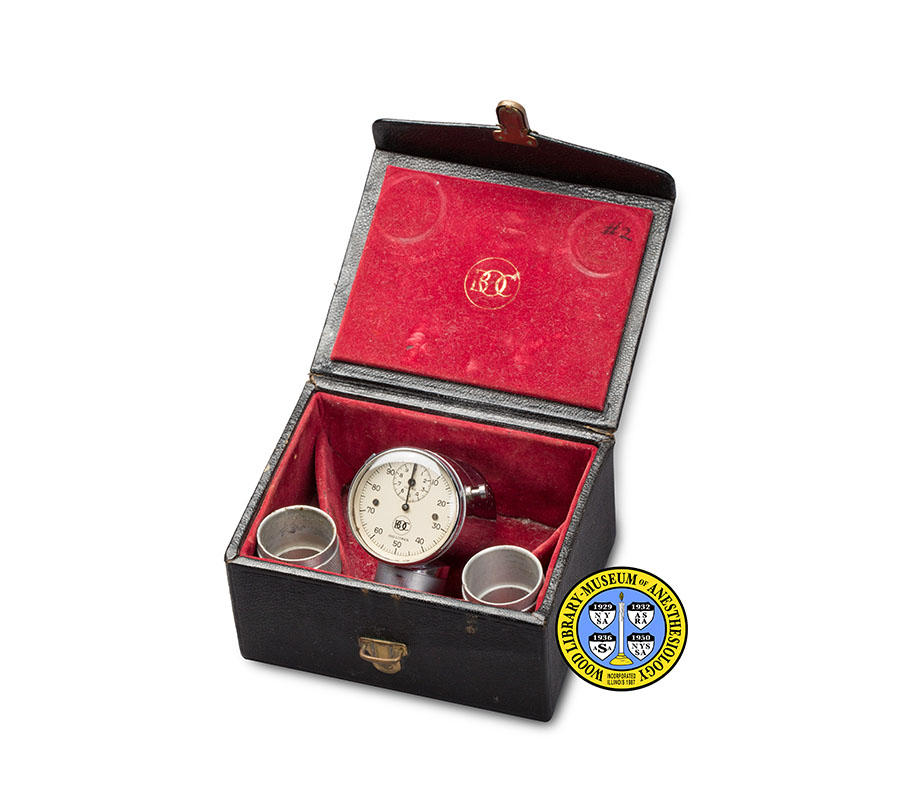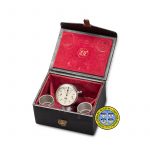Wright Respirometer
The Wright Respirometer, introduced around 1958, was used by anesthesiologists to monitor the functioning of the anesthesia ventilator. It was also occasionally used after surgery and anesthesia to assess whether a patient was breathing well enough on his own to have the endotracheal (breathing) tube removed. A Wright respirometer measures the volume (amount) of air exhaled during a single normal breath, or the volume exhaled over the course of one minute of normal breathing.
With the use of special adaptors, the respirometer was placed in the exhalation side of the breathing system. Inside the cylindrical housing of the device was a small turbine that was very sensitive to the flow of air in one direction only. As the exhaled breath of a patient moved past the vanes of the turbine, the resulting rotation was transferred to pointers on the clock-like face of the respirometer. The position of the pointers after a single exhalation, or after one minute of breathing, indicated in liters and fractions of liters the volume of air that had passed through the device.
This respirometer was invented by British physician and self-taught bioengineer Dr. B. M. (Basil Martin) Wright (1912-2001). Dr. Wright began developing instruments to measure breathing function while studying pneumoconiosis in miners for the United Kingdom’s Medical Research Council. Early in his service, he also invented the first peak flow meter, which measures how fast a person can move air out of his or her lungs after deeply inhaling and then exhaling as forcefully as possible.
Catalog Record: Wright Respirometer
Access Key: ampf
Accession No.: 2010-03-04-4 H
Title: Wright respirometer.
Author: Wright, B.M. (Basil Martin), 1912-2001.
Publisher: England : BOC [British Oxygen Company], [between 1958 and 1975?].
Physical Descript: 1 respirometer : metals, glass, paperboard, leather, velvet ; 5.5 x 11 x 9 cm.
Subject: Respiratory Function Tests.
Subject: Lung Volume Measurements – instrumentation.
Note Type: General
Notes: The early year (1958) in the date range for the possible year of manufacture
is based on the earliest publication in which the Wright respirometer is
found to be in (a publication of a 1958 symposium on pulmonary ventilation).
The later year (1975) for the possible year of manufacture is based on the
year that British Oxygen Company ran a rebranding campaign, changing its name
and logo. This vaporizer has the logo that dates before 1975. The date range
could change if documentation or expert opinion indicate the range should be
corrected.
Note Type: With
Notes: For purposes of completeness of photography, the respirometer and case where
photographed with two breathing system adaptor’s from a separate acquisition
(2013-1-22-2 E and F).
Note Type: Citation
Notes: Adeney M. Smith, Sir Leslie Edward George (1919–2006). Oxford Dictionary of
National Biography website. https://www.oxforddnb.com/view/article/97324.
Accessed October 27, 2015.
Note Type: Citation
Notes: Discussion on measureing respiratory mentilation. In: Harbord RP, Woolmer R,
eds. Symposium on Pulmonary Ventilation. Altrincham: John Sherratt & Son;
1959:87-98.
Note Type: Citation
Notes: Garrow J. Dr Martin Wright. The Independent. Friday, March 16, 2001.
https://gracemed.net/uploads/The_Independent_-_Dr._Martin_Wright.pdf.
Accessed October 28, 2015.
Note Type: Citation
Notes: Hunsinger DL, Lisnerski KJ, Maurizi JJ, Phillips ML. Accessory devices for
inhalation therapy. In: Respiratory Technology: A Procedure Manual. Reston,
Virginia: Reston Publishing Company; 1973;215-217.
Note Type: Citation
Notes: McPherson SP. Bedside pulmonary function and monitoring devices. In:
Respiratory Therapy Equipment. Saint Louis: The C. V. Mosby Company;
1977:161-162.
Note Type: Citation
Notes: Wolff H. Martin Wright: inventor who developed the breathalyser, reduced cot
deaths and helped asthmatics. The Guardian. Thursday, March 22, 2001.
https://www.theguardian.com/news/2001/mar/23/guardianobituaries. Accessed
October 28, 2015.
Note Type: Physical Description
Notes: One Wright respirometer held in a small leather covered case; The measurement
in the physical description field are of the case, closed with the
respirometer inside; The respirometer itself, treating the side with the
‘face’ as the front, measures approximately 6 x 4.5 x 6.5 cm (height x width
x depth); The working parts of the device are held in a metal cylindrical
tube; The cylinder is horizontal and one end contains the ‘face’ of the
respirometer; The face is circular and contains two circular scales; The
larger scale is marked in increments of one from 0 to 99, and is numbered at
0, 10, 20, 30, 40, 50, 60, 70, 80, and 90; The smaller circular scale is
located in the upper half of the face and is also marked in increments of one
from 0 to 99, and numbered at 0, .1, .2, .3, .4, .5, .6, .7, .8, and .9; The
larger scale is calibrated in 1 liter per increment, and the smaller scale is
incremented in fractions of a liter; Marked in the lower half of the face is
the BOC logo, and below that is “100 LITERS”; Extending from below the
cylindrical housing is an inlet connection; On the upper left side of the
cylinder is a lever that may be slid into an “OFF” or “ON” position’ On the
right upper side is the cylinder is a push button to reset the dials; A
metallic sticker has been applied to the top of the cylinder; It is marked
with, “HARRIS-LAKE INC. [new line] MEDIAL EQUIPMENT [new line] CLEVELAND,
OHIO”; Extending from the back of the cylindrical housing is an outlet
connection; Marked along the diameter of the back of the cylinder is the
following, “WRIGHT RESPIROMETER BRIT. PAT. 765206” and “4786 [new line] MADE
IN ENGLAND”; The case is lined with a red velvet and has the BOC logo stamped
on the inside lid; Low dividers create three compartments within the case;
One for the respirometer and two for connections; The lid of the case snaps
shut; The outside of the case is covered with black leather; Handwritten in
white ink on the top of the case is the following, “ANESTHESIA [new line] O.R
[new line] 5 NORTH”.
Note Type: Reproduction
Notes: Photographed for the WLM by Mr. Steve Donisch in June, 2015.
Note Type: Acquisition
Notes: Donated to the WLM by Mark E. Schoreder, M.D.
Note Type: Historical
Notes: The Wright Respirometer, introduced around 1958, was used by
anesthesiologists to monitor the functioning of the anesthesia ventilator. It
was also occasionally used after surgery and anesthesia to assess whether a
patient was breathing well enough on his own to have the endotracheal
(breathing) tube removed. A Wright respirometer measures the volume (amount)
of air exhaled during a single normal breath, or the volume exhaled over the
course of one minute of normal breathing.
With the use of special adaptors, the respirometer was placed in the
exhalation side of the breathing system. Inside the cylindrical housing of
the device was a small turbine that was very sensitive to the flow of air in
one direction only. As the exhaled breath of a patient moved past the vanes
of the turbine, the resulting rotation was transferred to pointers on the
clock-like face of the respirometer. The position of the pointers after a
single exhalation, or after one minute of breathing, indicated in liters and
fractions of liters the volume of air that had passed through device.
Early flow-sensitive respiratory testing devices such as this were often
referred to as “respiratory anemometers.” Anemometers are devices used for
measuring wind speed. As the number and type of instruments created for
measuring respiratory function increased the names for each type were refined
This respirometer was invented by British physician and self-taught
bioengineer Dr. B. M. (Basil Martin) Wright (1912-2001). Dr. Wright began
developing instruments to measure breathing function while studying
pneumoconiosis in miners for the United Kingdom’s Medical Research Council.
Early in his service, he also invented the first peak flow meter, which
measures how fast a person can move air out of his or her lungs after deeply
inhaling and then exhaling as forcefully as possible. People with certain
diseases have low peak expiratory flow rates. Dr. Wright is also known for
inventing a neonatal apnea monitor, and for contributing to the development
of breathalyzers.
Note Type: Publication
Notes: Campbell D. The Wright anemometer. Br Med J. 1960;2(5203):943. https://www.
ncbi.nlm.nih.gov/pmc/articles/PMC2098139/. Accessed October 28, 2015.
Note Type: Exhibition
Notes: Selected for the WLM website (noted October 27, 2015).


